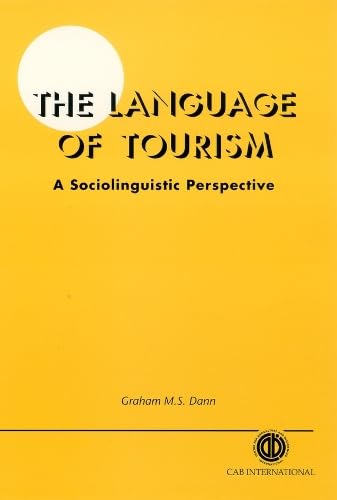
Synopsis
Languages convey messages, have a heuristic or semantic content, and operate through a conventional system of symbols and codes. In this book, it is shown that tourism, in the act of promotion, as well as in the accounts of its practitioners and clients, has a discourse of its own. The language of tourism is however much more than just a metaphor. Through pictures, brochures and other media, the language of tourism attempts to seduce millions of people into becoming tourists and subsequently to control their attitudes and behaviour. Tourists, in turn, contribute further to this language through the communication of their experiences. This book provides the first sociolinguistic treatment of tourism. It draws on both semiotic analyses of tourism and on the content of promotional material produced by the tourism industry. The author writes in a way that is both rigorous but accessible. Providing a highly original treatment, the book is of interest to all studying tourism from a social science perspective. In addition, it has important implications for tourism marketing and for professionals in the tourism industry.
"synopsis" may belong to another edition of this title.
About the Author
CABI
From the Back Cover
Languages convey messages, have a heuristic or semantic content, and operate through a conventional system of symbols and codes. In this book, it is shown that tourism, in the act of promotion, as well as in the accounts of its practitioners and clients, has a discourse of its own. The language of tourism is however much more than just a metaphor. Through pictures, brochures and other media, the language of tourism attempts to seduce millions of people into becoming tourists and subsequently to control their attitudes and behaviour. As tourists, such people then contribute further to this language through the communication of their experiences. This book provides the first sociolinguistic treatment of tourism. It draws on both semiotic analyses of tourism and on the content of promotional material produced by the tourism industry. The author writes in a way that is both rigorous but accessible. Providing a highly original treatment, the book is of interest to all studying tourism from a social science perspective. In addition, it has important implications for tourism marketing and for professionals in the tourism industry.
"About this title" may belong to another edition of this title.
Search results for The Language of Tourism: A Sociolinguistic Perspective...
The Language of Tourism : A Sociolinguistic Perspective
Seller: Better World Books Ltd, Dunfermline, United Kingdom
Condition: Good. Ships from the UK. Former library book; may include library markings. Used book that is in clean, average condition without any missing pages. Seller Inventory # GRP33155032
Buy Used
Quantity: 1 available
The Language of Tourism: A Sociolinguistic Perspective (Cabi Cabi)
Seller: Phatpocket Limited, Waltham Abbey, HERTS, United Kingdom
Condition: Good. Your purchase helps support Sri Lankan Children's Charity 'The Rainbow Centre'. Ex-library, so some stamps and wear, but in good overall condition. Our donations to The Rainbow Centre have helped provide an education and a safe haven to hundreds of children who live in appalling conditions. Seller Inventory # Z1-C-038-03121
Buy Used
Quantity: 1 available
Language of Tourism : A Sociolinguistic Perspective
Seller: GreatBookPrices, Columbia, MD, U.S.A.
Condition: New. Seller Inventory # 18790656-n
The Language of Tourism: A Sociolinguistic Perspective
Seller: PBShop.store UK, Fairford, GLOS, United Kingdom
HRD. Condition: New. New Book. Shipped from UK. Established seller since 2000. Seller Inventory # FW-9780851989990
Buy New
Quantity: 15 available
Language of Tourism : A Sociolinguistic Perspective
Seller: GreatBookPrices, Columbia, MD, U.S.A.
Condition: As New. Unread book in perfect condition. Seller Inventory # 18790656
Language of Tourism : A Sociolinguistic Perspective
Seller: GreatBookPricesUK, Woodford Green, United Kingdom
Condition: New. Seller Inventory # 18790656-n
Buy New
Quantity: Over 20 available
The Language of Tourism
Seller: Majestic Books, Hounslow, United Kingdom
Condition: New. pp. 310. Seller Inventory # 7358509
Buy New
Quantity: 3 available
The Language of Tourism A Sociolinguistic Perspective (Cabi Cabi)
Seller: Kennys Bookshop and Art Galleries Ltd., Galway, GY, Ireland
Condition: New. 1996. First. Hardcover. In this work, it is shown that tourism, in the act of promotion, as well as in the accounts of its practitioners and clients, has a discourse of its own. The text draws on both semiotic analyses of tourism and on the content of promotional material produced by the tourism industry. Num Pages: 304 pages, index. BIC Classification: CFB; KNSG. Category: (P) Professional & Vocational; (UP) Postgraduate, Research & Scholarly; (UU) Undergraduate. Dimension: 244 x 165 x 22. Weight in Grams: 620. . . . . . Seller Inventory # V9780851989990
Buy New
Quantity: Over 20 available
Language of Tourism : A Sociolinguistic Perspective
Seller: GreatBookPricesUK, Woodford Green, United Kingdom
Condition: As New. Unread book in perfect condition. Seller Inventory # 18790656
Buy Used
Quantity: Over 20 available
The Language of Tourism
Seller: Books Puddle, New York, NY, U.S.A.
Condition: New. pp. 310. Seller Inventory # 26522226
